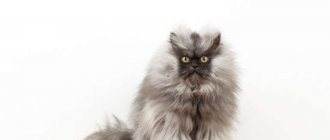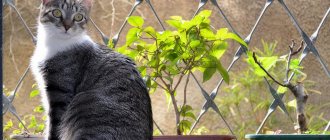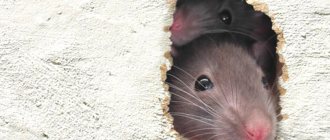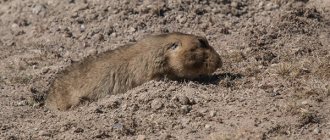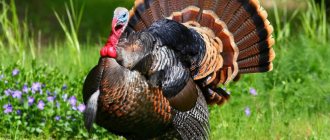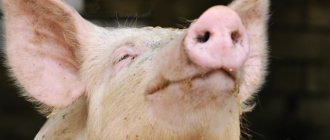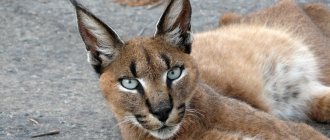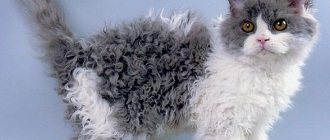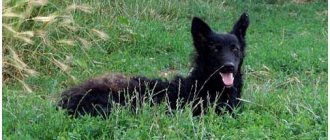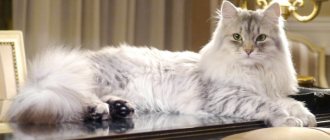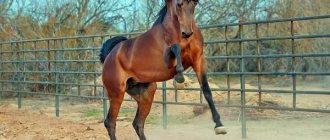Hamsters (Cricetidae) are small animals from the order of rodents. There are wild and domestic varieties that live in different parts of the globe. In total there are more than 80 genera, uniting more than 400 species. Among them are common, Syrian, white-footed (deer), field, South American, hairy-footed, highland, dormouse, mole, rice, cotton, fish-eating, red-nosed hamsters.. About the species that are kept at home, as well as some of those that found only in the wild, we will tell you in this article.
Hamster - description, structure, characteristics. What does a hamster look like?
A hamster is a small or medium-sized rodent with a fairly dense build, 4 short legs with sharp claws, a small rounded head with a slightly pointed muzzle, small or rather large (like field hamsters) ears, long mustaches, dark beady eyes and a tail from 4 mm to 23-24 cm in length (like hymenoplasty or forest hamsters).
The hamster's tail can be either almost naked (for example, in rat-like hamsters) or fluffy (for example, in the Neotoma cinerea hamster). Photo by: Klaus Rudloff
Taken from the site: insolitanaturaleza.blogspot.ru
Many hamsters resemble rats or mice in their appearance, some look like a squirrel or a dormouse (dormouse hamsters, hamster neotoma cinerea).
By the way, dormouse hamsters have large black eyes, which give the muzzle an expression of surprise, and there are rings of darker fur around the eyes.
Photo credit: Andreas Fink, CC BY-SA 2.5
Depending on the species, the body length of a hamster can vary from 4-5 cm (Roborovsky hamster) to 34 cm (common hamster). The weight of a hamster also depends on the variety and varies from 7 g (for dwarf hamsters) to 700 g or more (for an ordinary hamster). Sexual dimorphism in these animals is practically not expressed, although in some species the females are slightly larger than the males. The hamster's vision is rather weak, but its hearing and sense of smell are perfectly developed. The animals communicate using ultrasounds and squeaks, which are distinguishable by the human ear.
The hamster has 16 teeth, four of which are the front incisors, located in pairs above and below, and 12 molars. A hamster's teeth grow throughout his life, so the rodent must grind them down. Surprisingly, the animal’s teeth are covered with strong enamel only in front, and on the back there is practically no enamel layer.
Taken from: www.omlet.co.uk
The hamster's fur is generally soft, but some varieties (such as rice hamsters) may have coarse hairs, and cottonmouth hamsters have very coarse, almost bristly hair on the back. The color of the rather thick fur of a mammal can be very diverse. The color of hamsters living in the wild varies from brown-gray, ashy, brown and almost black to red-ocher and golden. The hamster's fur on its abdomen and legs can be white, cream, black, grayish or yellowish. In some species, for example, the Djungarian hamster, a clear gray or black stripe runs along the back. In some species (for example, field hamsters), the tail can be two-colored: dark on top and white below. The soles of the animals' hind legs can also be covered with thick fur, as, for example, in hairy-footed hamsters of the genus Phodopus. By the way, Djungarian hamsters belong to this genus.
Photo credit: Ignacio Icke, CC BY-SA 2.5
A distinctive feature of many hamsters (except for the South African Mystromys albicaudatus and some others) are cheek pouches - unusual muscle cavities that are located on the sides of the head, passing into the neck and shoulder area. The cheek pouches of hamsters serve as a kind of storage room where the animals temporarily store their food in order to later eat it in a secluded place or hide it for storage. In these bags, animals can carry up to 50 g of their favorite treats at a time. In some species of hamsters, the inner surface of the pouches has glands that produce a secretion that has a strong odor. It helps adult hamsters normalize the digestive process and strengthen the immune system, and in baby hamsters it promotes proper growth and development. There are suggestions that this odorous substance gives animals the ability to smell food that was previously hidden in a secluded place. By the way, some hamsters swim and dive well, taking air into their cheek pouches. For example, rabbit and webbed hamsters even have swimming membranes between the toes of their hind legs.
Brief description of breeds
It is not possible to describe all types of hamsters in one article, so we will pay a little attention to only some of them, specifying their name and attaching a few photos.
Golden homa
It is also often called Syrian. Currently, it is this breed that holds the palm in popularity. Rodents are quite large (half the size of a rat), but not so large that they can be entrusted to a small child.
The color of the fur coat fully corresponds to the name of the breed: medium-length fur is usually reddish, golden or brownish-brown in color. There are black, white, spotted and even apricot colors.
Fiery beauties prefer loneliness to the noisy company of their relatives, but at the same time they always happily communicate with household members, quickly get used to being handled and love affection.
Angora breed
It is not difficult to guess that this breed of hamster belongs to the long-haired category. Its second name is royal. Even in photos the animals look great, and in real life they behave like royalty.
This species originated from Syrian hamsters, and received its name due to its lush hair - by analogy with Angora cats. These rodents have nothing in common with Angora.
Unlike their ancestors, golden ones, they are distinguished by a wide variety of colors: white, cream, silver, tricolor. Surprisingly, males have much longer hair than females.
Dzungarian breed
Dwarfs among their fellow tribesmen. The fur is a smoky gray color with a clearly defined dark stripe along the back and a characteristic diamond shape in the forehead area. Ears are black, paws are white. Average length - 10 cm.
Unlike the previous species, hamsters are independent and do not particularly like human attention. They have an eccentric character - they often fight in the group
Therefore, it is better to keep them alone or place them in a group of the same age from birth. They are mainly nocturnal.
Campbell
Another little one of a kind. They are often confused with Dzungarians, although the differences are visible at first glance:
- firstly, the color of this breed of hamster is yellow-brown;
- secondly, the stripe on the back and the diamond on the forehead are not clearly drawn.
They also prefer loneliness, so this species is bred more for observing their life and habits than for communication.
Sungur breed
A distinctive feature is large bulging eyes, a convex nose, a curved sacrum and shaggy legs, for which the hamster received the nickname furry-legged.
Roborovsky breed
Quite a rare breed, although many would like to have these incredibly nimble, active and funny kids. At one time it practically disappeared from the face of the earth, but American scientists managed to restore and even increase the population.
True representatives of the species are truly tiny creatures and are considered the smallest, not counting Taylor's dwarf, among all types of domestic hamsters. It is better to keep rodents in pairs or even small family groups.
The coloring is characteristic of deserts and semi-deserts: white belly, pinkish back, black ears with a white border.
Taylor's dwarf
This is actually a wild breed, but adapts well to life in captivity. They willingly communicate with people and feel quite at ease in a cage - they prefer a well-fed and calm life.
The size is tiny - only 5 cm.
By the way, such dimensions require special careful selection of the cage, but it is best to keep babies in a glass or plastic container that would be difficult for them to chew through.
Ordinary
Gulliver is the most unique among the entire family of hamsters: average height is 25 cm. Despite the ordinary and ordinary name, the hamster is distinguished by its bright and contrasting color:
- red back;
- black belly;
- on the muzzle and on the sides there are two light spots separated by a black stripe.
There are also pets with a calmer coat: black or black and white.
Yin Yang
It is difficult to say that black and white animals are some kind of separate breed of hamsters.
For example, albinos can be found among Djungarians, Syrians and Campbells. In nature, white rodents are easy prey for predators, so there are few of them in their natural habitat. Among breeders, the snow-white color is highly valued.
Black hamsters are just as rare as white ones. Typically, Charcoal hamsters are born in a litter of Syrian or Dzungarian breeds.
Siberian animal
Another breed of hairy legs. Externally, Siberians are very similar to Djungarians and just like they change their dark color to lighter in winter. Rodents are very small and nimble, so it is better to keep them in a glass terrarium. In extreme cases, a cage will do, but with a very small intersection space.
Djungarian hamster
Djungarian hamsters are dwarf hamsters. Their body length is only 9-10 cm, and their weight is about 50 grams. The Djungarian's coat is fluffy, gray, with a distinctive dark stripe along the ridge on the back. A black diamond is clearly visible on his forehead. In winter, the color may change to silver-gray, although this rarely happens in captivity. There is fur on the soles of the paws.
The most common color is gray, less often dark brown.
It is curious that the manner of grasping food in these hamsters is similar to that of humans: they hold the treat with both hands. By nature, they are affectionate, sociable and peace-loving creatures. They are willing to be held and love to sleep on their owner's lap. Djungarians bite extremely rarely, for example, if a person’s hands smell of something tasty or when a female is protecting her cubs. Therefore, these pets often live in apartments; they can be owned even if there are small children in the family.
It is not advisable to keep adult individuals together - this can lead to fights for territory and frequent pregnancy of the female. Hamsters of this breed are clean and practically odorless.
Conditions of detention:
- a cage measuring 30*50 cm, with frequently spaced bars;
- the cage should have a wheel with a continuous running surface - a diameter of 13-17 cm will be sufficient;
- single occupancy.
In captivity, with good maintenance, Djungarian hamsters live on average 3 years.
The nature of rodents and their habits
Of course, the character of a furry friend depends on the attitude of the owners towards him and on the conditions of detention. But each breed has its own distinctive characteristics. For example, Djungarians are a little wild and vulnerable, Syrians are good-natured and calm, and the Radde hamster is a very willful animal that can sometimes show aggression.
The habits are similar in all rodents, regardless of breed. They like:
- chew on everything - the bars of the cage, your house, toys, etc. If Homa suddenly gets lost in the apartment, then do not be surprised to find chewed wires;
- bury yourself in the litter and hide in the house;
- run away at the first opportunity;
- make food supplies. If you notice that your furry miracle’s bowl is emptying too quickly, this does not mean that the cheeky one ate everything; he probably hid most of the food somewhere;
- run in a wheel. This desire is especially aggravated in the furry in the evenings and at night.
In order for the animal to satisfy its need to chew, there must be a special sharpening stone or at least twigs in its cage, otherwise the homa will begin to sharpen its teeth on its toys. Sometimes a pet has a desire to taste the teeth of its own owners. Remember that he doesn't want to hurt you, he's just experiencing the world that way. Even if your pet has bitten you painfully, you should not punish him or scream, because he may get scared and offended. Hamsters have other fears, which we will talk about in more detail.
Campbell
Campbell's hamsters have long been considered a subspecies of the Djungarian hamster. They were later identified as a separate species in honor of the discoverer, Charles William Campbell. Body size from 7 to 10 cm, weight 40-60 g. Eyes black or red. The Campbell hamster has a rounder muzzle than the Djungarian hamster.
Life expectancy is on average 3 years. Standard color is sandy grey. The fur coat can also be cream or brown.
There is a gray stripe on the back, like a Djungarian hamster. Campbell's stripe is lighter, Djungarik's is darker and more distinct.
Like most hamsters, Campbell should not be kept in the same cage as his fellow hamsters. This species is quite difficult to tame compared to other species. Many individuals are quite aggressive even towards humans, often biting.
Lifestyle
For a comfortable and safe life, a hamster in the steppe needs to equip its home. Usually they use a burrow built by themselves, consisting of several storerooms, a nesting area (sleeping area) and numerous passages (entrances and exits).
In general, wild hamsters live a “bachelor” life, meeting with the opposite sex only during the breeding season. It usually occurs in the spring and summer months.
Even females do not take very long to care for their babies. As soon as the month hits, their mother throws them out the door and is ready to meet a new suitor who will inseminate her again.
During the winter, the animals usually hibernate. But if the weather is good and warm, they can wake up and go to the surface for airing.
All hamsters, like any other underground dwellers, have poor eyesight. Apparently this is why they prefer not to crawl out of their burrows during daylight hours. Their sense of smell and hearing are excellent.
Wild hamsters are difficult to habituate. The only exception is the Transbaikal species, which can often be found in the homes of local residents.
Campbell
Campbell's hamsters have long been considered a subspecies of the Djungarian hamster. They were later identified as a separate species in honor of the discoverer, Charles William Campbell. Body size from 7 to 10 cm, weight 40-60 g. Eyes black or red. The Campbell hamster has a rounder muzzle than the Djungarian hamster.
Life expectancy is on average 3 years. Standard color is sandy grey. The fur coat can also be cream or brown.
There is a gray stripe on the back, like a Djungarian hamster. Campbell's stripe is lighter, Djungarik's is darker and more distinct.
Like most hamsters, Campbell should not be kept in the same cage as his fellow hamsters. This species is quite difficult to tame compared to other species. Many individuals are quite aggressive even towards humans, often biting.
Taylor
Taylor is the most decorative of all types of domestic rodents. This miniature pet grows to a maximum of 8 centimeters. However, the main feature of this breed is that the female and male care for their offspring together, which is quite a rare occurrence for hamsters. For livestock breeders planning to keep a couple of pets, this is one of the best options.
Another characteristic feature of this species is that they often bite. The animal can bite the “feeding” hand at the most inopportune moment, so it is not advisable to give representatives of the breed to children of preschool age. When caring for a pet, it is advisable to use a special glove.
Breeds of wild hamsters
An adult hamster reaches a length of up to 35 cm and a weight of up to 1 kg. A very harmful hamster, he likes to live near people and is a frequent visitor to gardens. This hamster is protected in many countries: Poland, Germany, Ukraine, Belarus, France, Belgium.
Listed in the Red Book. An adult grows up to 13 cm in length. Habitat: steppes, semi-deserts.
This species is widespread in the North Caucasus, Georgia, and the Stavropol Territory. It causes great harm to agriculture and is also a carrier of the dangerous infection tularemia. Dimensions up to 28 cm.
A small hamster, slightly larger than a rat, up to 16 cm. Lives in Kazakhstan, the Volga region, and Trans-Urals. In captivity it is well tamed. In some regions of Russia, such a hamster is listed in the Red Book.
A small hamster, slightly larger than a mouse, up to 15 cm. Belongs to the Eversmann hamster species. This hamster has a light brown color. It lives in China and Mongolia.
This individual belongs to the gray species of hamsters. It got its name in honor of the Barabinsk steppe of the same name. Usually such hamsters are small in size, up to 13 cm.
This hamster is the size of a mouse. Lives in Mongolia and Siberia. In size, up to 13 cm.
Transcaucasian hamster. The length of the individual is up to 18 cm. It lives in Turkey, Lebanon, Israel and the Eastern Ciscaucasia.
Named in honor of zoologist V.E. Sokolova. Body length up to 114 cm. Lives in Mongolia and China.
They are classified as dwarf hamsters, up to 12 cm. Such hamsters have a characteristic elongated body and longer legs. Found in China and Mongolia.
Lives in northern Bulgaria and Romania. Body length up to 17 cm. Life expectancy about 2 years.
Belongs to dwarf hamsters, up to 8 cm. Habitat: North America. Minks are built in the grass.
Body length up to 13 cm. Habitat: Canada, North America. An interesting feature is that from time to time they can sit down and emit a short high-pitched squeak for 1-2 seconds.
Refers to dwarf hamsters. Habitat: Eastern Siberia.
The body length is up to 11 cm. The color of the fur coat is dark gray. Habitat: Western China.
The body length of such a hamster reaches up to 25 cm. It lives in Northeast China, the Korean Peninsula, Primorsky Krai, and the Jewish Autonomous Region. The color is predominantly gray-brown.
Lives in the mountainous regions of Tibet, South Asia, China. Body length up to 10 cm.
This hamster measures up to 10 cm in size and weighs up to 100 grams. Habitat: China.
Lives in the southwest of Transbaikalia. Length – up to 12 cm. Burrows are built among the rocks.
As you can see, there are simply a huge number of hamsters living on Earth. We hope that after reading this text you have become a little more familiar with these interesting animals.
Rodent distribution
The largest populations of hamsters live in steppe and forest-steppe zones. In addition, some species live in wet areas along rivers and in mountains at altitudes of up to 3600 m above sea level. Rodents often prefer rice fields, vegetable gardens, orchards and other cultivated areas. Their range covers a large area. Large populations are present in Eastern and Central Europe. Hamsters are also found in Siberia and Asia Minor. Especially many animals live in Iran, Syria, Mongolia, Korea and China. To provide the necessary conditions for the hamster, you need to know where the species was brought from.
Hamsters live in steppe zones.
Simple wire cutters
The most primitive device is very similar to ordinary scissors. Only one of its cutting surfaces is equipped with a small notch with a sharp edge. Using such a device is easy, provided you have some skill and experience. For young dogs, nail trimming is always stressful. They do not want to sit quietly, they strive to tear the paw out of the owner’s hands and in every possible way complicate the process. So Litbro.ru will not recommend such a gadget to novice dog breeders. The risk of causing serious physical injury to your pet is too great. Well, for experienced owners who have used similar tools more than once, nothing better can be desired. Cheap and very effective.
Cost – 35 – 72 rubles.
More advanced versions of hand cutters offer expanded functionality.
Although their main part, in the old fashioned way, is based on two cutting surfaces. Service additions imply only human convenience. Models with rounded ends, a container for cut claws and lighting have proven themselves very well. The fact is that some dogs have the habit of looking for clipped ends on the floor and eating them. Sharp, bent cuttings can damage the stomach wall and cause bleeding. A small “waste collection” effectively solves this problem.
Price – 636 rub.
Another gadget from the line of simple nippers has comfortable ergonomic handles that allow you to securely hold the tool while trimming nails.
This is important when the animal gets nervous and breaks out.
We pay attention to one more detail - the expansion spring. It fixes the cutting surfaces in the open state, which makes the operation somewhat easier.
Otherwise, the functions of the device duplicate all the features of its predecessors. To properly shorten claws, you must have the skill and achieve unquestioning obedience from your dog or cat.
Cost – 229.93 rubles.
Diseases
The black rodent, like the white one, is very vulnerable to disease. They are vulnerable to diseases. Stress, hypothermia, poor nutrition and maintenance can lead to weakened immunity of a dwarf pet. As a result, he gets sick.
Signs of the disease:
- begins to sneeze, sniffle;
- refuses food and drink;
- suddenly loses weight;
- eyes fester and water;
- Aggression and increased drowsiness appear.
If you notice these signs in an animal, you should urgently show it to a veterinarian. Remember, self-treatment of a fluffy can aggravate the situation and lead to irreversible consequences.
Albino hamster with red or black eyes
And again we have to disappoint you - there is no separate breed of albinos with a specific eye color. Almost any living creature (even humans) can be born an albino.
Usually hamsters have black eyes, but albinos often have impaired eye pigmentation (this is the color on the inner surface of the eyeball). As a result, it becomes transparent and the red color we see is blood vessels.
An albino with any eye color is no different in caring for an ordinary animal of the same breed.
Roborovsky
Roborovsky are the unique smallest individuals of dwarf hamsters. Adults grow to four to five centimeters. They have long legs and, unlike other hamster breeds, do not have stripes on their spine. Their character is quite active. These are nimble and independent rodents. They cannot sit in one place. It is impossible for Roborovsky to run out of the cage. Then it is very difficult to catch him.
In this article, we tried to tell you about the most popular types of hamsters. All hamsters are interesting in their own way. We wish you to find your pet!
Many pet lovers, before getting such a cute hamster, will definitely find out what colors hamsters come in in order to choose the most suitable option for themselves. However, it is simply impossible to answer this question unambiguously. Indeed, today there are dozens of rodent breeds, each of which has a certain size, hair length and, of course, color. We will tell you about the most common ones so that each reader can decide which breed is right for him.
One of the most common, famous and well-studied breeds. Therefore, many breeders are interested in the colors of Djungarian hamsters. Its natural habitat is Western Siberia, Northeast Kazakhstan, Central and Central Asia. Most often it inhabits steppes and semi-deserts.
In order to reliably hide from dangerous predators, it has a camouflage color - this is the only protection for a hamster in open areas that do not have bushes or other natural shelters. The back has an ocher-gray or brownish-gray color. A little darker on the sides. But the belly is usually light - the border between the dark sides and the light gray belly is clearly visible. On the ridge you can see a narrow black stripe; the snakes are also blackish, although they are almost white on the inside.
Unlike many other breeds that live in milder climates, Djungarians change color depending on the time of year. So, in winter it is almost white, only a silver-gray stripe remains on its back. In summer, the wool is gray, blending well with the dry ground.
Habitat
The main habitat of the animal:
- Northern China (Manchuria);
- Korean Peninsula;
- Primorsky Krai (Russia);
- Jewish Autonomous Region;
- South-east of the Amur region.
Most often you can find it in swamps in dense bushes, on lake shores and in river valleys
He also pays attention to agricultural lands: fields and irrigation canals. Sometimes you can find it on the side of roads and even in residential buildings
In some areas of China, rodents are being intensively combated to protect cereal crops. This type of hamster is popular as a laboratory animal for conducting various types of experiments.
When meeting representatives of these hamsters in nature, you should not try to catch them, pick them up or stroke them. Rodents are carriers of various infections, often dangerous to humans. When dealing with wild animals, safety precautions should be taken extremely carefully. Knowing about these features of the rat-like hamster, breeders use gloves when handling the animal at home.
Names of hamster breeds and external characteristics
Often the choice of an animal is based on its appearance, but it is worth knowing the characteristics of its character and habits in order to make the right and informed choice (see care and maintenance of a hamster at home).
Syriac (also known as golden or royal)
The most popular breed for keeping at home, which is liked by both children and adults (see more about the Syrian hamster, features of care and character):
- Body length – 13-19 cm.
- Golden rodents are most common, but grey, beige and even black ones can also be found.
Usually has a calm character, loves affection and is very easy to tame. Rarely gets sick, but the average life expectancy is short and averages 2 years.
Dzungarian
- Their length does not exceed 10 cm.
- A distinctive feature is a stripe on the back and a diamond in the forehead area.
- The standard color ranges from almost white to dark gray, with black, brown and gray colors predominating.
These little fidgets are distinguished not only by their tiny size, but also by their good-natured disposition. They very rarely bite and quickly get used to being handled. Despite this, they cannot be called a good choice for a small child. Their small size makes their body very fragile, which prevents them from being squeezed or squeezed.
At home, it is better to keep dzhungariks alone. Same-sex couples very rarely get along. The female and male will constantly bring offspring, which will lead to fights for territory and will force you to search for owners for the babies. With proper care and quality nutrition, the dwarf will live 2-2.5 years.
Angora
Not a separate breed, fluffy hamsters are a type of Syrian.
- They are distinguished by long, fluffy and pleasant to the touch fur.
- They can have a wide variety of colors: from cream to black. Spotted and tortoiseshell colors are rare.
- Males have a fur coat up to 5 cm long, females are much more modest, their fur rarely exceeds 2 cm.
Campbell
Another representative of dwarf rodents, which are often mistaken for dwarf rodents.
- Their bare hind legs give them away
- And stripes on the sides.
Campbell's predominate colors are brown, sand and cream. Unlike other dwarf hamsters, they are difficult to tame. They can bite the owner and are not particularly friendly to other animals. For this reason, they should not be left in the same cage with hamsters of different breeds. This will inevitably lead to a fight.
At the same time, you should not think about which Campbell dogs are not suitable for taming. It just takes more time and effort.
Taylor
Very miniature look.
- Adult body weight is only 8 g
- With a length of 8 cm.
The main feature of this species is that the male and female care for their babies together. This behavior is usually characteristic of mice. If you want to keep a couple, this is a great option.
Radde (Pre-Caucasian, Dagestan)
Outwardly similar to the Syrian, but:
- It has large sizes - from 17 to 28 cm.
- Usually brown with dark and light spots.
Radde is a rather rare pet. This breed of large hamster is a pest in the wild. It lives in burrows and rarely comes out into daylight. The rodent often becomes a carrier of infectious diseases that are dangerous for both livestock and people.
If you decide to get a radde, be prepared to work hard to tame it. Also, do not try to switch the night dweller to a mode that is more convenient for you. Staying awake during the day will negatively affect both the health and mood of the animal.
Roborovsky
The smallest and rarest representatives of their species.
- Adults barely reach 4-5 cm.
- They have long legs.
- Unlike other dwarf breeds, they do not have stripes on their backs.
These kids are very active, fast and independent. They absolutely cannot sit still! If one of them escapes from the cage, it will be very difficult to catch him.
This species is not suitable for solitary living. Alone, they feel very sad and live very short lives. In the wild they form small communities. It’s worth starting a couple or a whole family at home. Then these sociable creatures will feel comfortable, and you will be interested in watching their life.
Albinos
In fact, white hamsters with red eyes are not a separate breed. The same applies to black hamsters; they can be of almost any breed.
Like all albinos, they are white with red eyes and a pink nose.
The information from the table will help you find out how to determine the breed of hamster. Of course, not all breeds are listed there. There are 240 species in total, but not all of them can live at home.
What do hamsters eat and what do they eat?
In the wild, these animals are rodents, which means that hamsters eat mainly grains. They are also always not averse to eating tender young shoots of plants, such as bamboo. In addition to cereals, the animal loves vegetables (potatoes, pumpkin, beets, carrots) and can even harm garden plantings. In order not to lack protein, the animals also periodically eat small creatures - insects, worms and even snakes. The rice hamster happily eats fish, the remains of which are left over from the dinner of other animals. Membranaceous often feasts on mollusks and crustaceans. Sleepy - Can't resist avocados and figs.
Syrian
The second most popular species is the Syrian hamster. This species is medium-sized and much larger: the body length is considered to be 12 cm, but there are individuals up to 20 cm tall (this is the largest hamster among pets). The usual color is golden (reddish, peach). Often, for marketing purposes, sellers call this breed Royal, and the name Yellow Hamster is found. Many consider it the most beautiful breed.
There are simply countless decorative colors obtained as a result of selection. The Syrian can be of almost any color, as well as multi-colored.
The character is a little more absurd than that of the Djungarians, but you can tame the Syrian. Females are angrier than males, so we recommend boys for solitary housing. If you are planning to get several Syrian animals, house them separately, even in pairs (only house them for the duration of mating).
They live 3-4 years; long-livers have been known to live up to 5 years.
We have outlined everything you need to know about the maintenance and nutrition of the Syrian breed in this article.
Angora hamster
There is no breed of Angora hamster. This is often the name given to Syrians who are extremely shaggy and have long hair (up to 10 cm). Decorative breed, famous for its fluffiness. The coat requires additional care - keep this in mind if you are planning to get a shaggy hamster.
Golden hamster
Naturally colored Syrians are most often called golden, but there are also representatives of other breeds of this color (for example, tangerine dzhungarik).
Additional questions and answers
There are some important questions to consider before purchasing a rodent. This will help you choose the right animal and provide it with good conditions.
What is the smallest breed of hamster
Roborovsky hamsters are the smallest breed suitable for home keeping. Among wild rodents, “Taylors” stand out for their compact size.
What is the largest breed of hamster
Among domestic breeds, Syrians are considered the largest. Karbysh is the largest wild rodent.
Who is better to get - a Djungarian or a Syrian hamster?
Both breeds have their advantages and disadvantages. Thus, “Syrians” are larger, have an easy-going disposition and quickly learn to respond to a nickname. However, they need a spacious cage. Djungarian hamsters do not require much space. Now many varieties of this breed have been bred, so it is easier to choose an animal with the desired decorative qualities. Syrian hamsters are easier to care for.
The largest rats in Russia
Animals are found everywhere in our country: in nature, near human habitation.
Among the wild varieties there are:
- large gray;
- black;
- Turkestan, red.
In Russia, the largest rat is the pasyuk, which grows up to 25 cm, excluding the length of the tail. At the same time, the weight reaches 400 g, sometimes there are individuals up to 500 g. Black ones are slightly inferior to gray ones, sizes reach 18 - 22 cm, with a weight of 300 g. The smallest are Turkestan red ones. Body length reaches 17 – 21 cm, weight – 280 g.
There are myths that huge mutants, reaching a weight of 1 kg, live in chemical plants, as well as among the inhabitants of sewers. Their size is compared to large cats. But this information has not received official confirmation.
Moscow metro drivers love to scare others with horror stories about huge rodents inhabiting underground tunnels. These animals are supposedly the size of a large dog and have red or green eyes that glow with an otherworldly light. Monsters are incredibly aggressive, immune to baits and poisons.
Pasyuki feed on food leftovers in landfills and can consume plant and animal foods. The invasion of rodents frightens many people with the impending damage to things and products, aggressive behavior, and the many dangerous pathologies that these animals suffer.
The pasyuk's closest relative is the black rat, which prefers to live in attics and warm, dry basements. The body length of an adult animal is 22 cm, weight is no more than 300 g. Both types of animals cannot be compared in size with a cat or a dog, so all stories about the invasion of giant rats should only cause irony.
The largest domestic rats
Many Russian residents keep rodents at home, considering them very smart and cute. The animals are bred in sterile laboratories, so they do not pose a threat to health. Decorative breeds are focused on communicating with people and become attached to their owner.
Depending on the breed, the size of the animals reaches 20 cm, with a weight of up to 350 g. There are also larger individuals that reach a weight of more than 500 g. But such a record is a consequence of overfeeding and the development of obesity in the animal.
Keeping a pet is inexpensive; rodents are unpretentious in food. They are fed with special food from the store or “human” food: vegetables, fruits, crackers, seeds. The average lifespan of a pet is about 2 – 3 years.
The largest breeds include:
Standard. The variety is widespread throughout the world. The body length reaches 30 cm, weight – up to 500 g. Despite their impressive size, the nature of the animals is calm and peaceful. They are unpretentious in food and do not bite their owner. It is not very convenient to walk on the street with representatives of the Standard breed. The large animal causes fear and misunderstanding among passersby. Life expectancy – 2 – 4 years. Large brown rat. This breed is often kept at home; adults reach 20 cm in length and weigh no more than 150 g.
Rodents live for about 2 years, so emotional people should pay attention to other species.
Rats, which have spread throughout the world, can become dangerous pests or cute pets. Among the representatives of the mouse family there are indeed large representatives that can frighten impressionable people with their size. On the territory of our country, the largest rats are gray, black, and Turkestan.
Reproduction and development of babies
All hamsters are “precocious” pets, their puberty occurs in 1-2 months. This is almost not reflected externally in females, but in boys the testicles begin to protrude. Sometimes they are so big that you are simply amazed!
Despite early sexual development in hamsters, care must be taken that they do not begin sexual activity too early. This is especially harmful for females, for whom pregnancy can end in death during childbirth. The optimal age for pregnancy is 4-5 months.
Here are some interesting facts about the reproduction of pet hamsters:
- pregnancy lasts about 3 weeks;
- after giving birth, within a week the female is able to become pregnant again;
- one married couple can produce up to 10 offspring per year!
- The number of hamsters in one litter can be from 4 to 15.
Newborn hamsters look very touching and defenseless. They are tiny, bald, with closed eyes. During the first days, the hamsters do not leave the nest, but within a week from the moment of birth they crawl throughout the cage in search of tasty seeds. At 2 weeks their eyes open and fluff appears on their body. And when the animals turn one month old, they are already completely independent.
Babies can be tamed after they open their eyes. Hamsters adapt to human interaction faster than adult hamsters. They are also easier to train.
Children of hamsters are shown in the photo:
Peculiarities
The hamster belongs to the order of rodents - these are small animals with short legs and tails, as well as small ears. Despite the fact that there are about 19 species, they are all similar to each other, and differ only in size and color, which depend on their habitat. Thus, the inhabitants of the desert plains received yellow or sandy fur. Hamsters living in the forest-steppe zone got a brown or gray skin. And rocks have black or dark brown fur. This allows tiny animals to safely camouflage themselves from attacks by aerial predators.
Nature has endowed hamsters with sharp and strong teeth - this allows them to cope with hard food such as nuts and grains. The animal has only 4 teeth, which grow throughout its life. Therefore, when kept at home, he needs a special mineral stone on which he will grind his teeth.
The hamster's diet is quite extensive, it includes:
- cereals and legumes;
- vegetables;
- fruits;
- roots;
- herbs;
- berries;
- nuts;
- seeds.
Some species, such as the Transbaikal and rat-like hamsters, also feed on insects and carrion. In the natural environment, a hamster has access to food only in the summer-autumn period, so an animal of any breed will definitely stock up for future use. To do this, he has special cheek pouches that allow him to store food and transfer supplies to storage.
So, we can conclude that a hamster needs a fairly rich diet to provide the body with the necessary elements. As the basis of a pet’s diet, a special food mixture, additionally enriched with vitamins, is perfect. In summer, hamsters need to receive fresh vegetables, fruits, berries and herbs. Suitable for this:
- carrot;
- broccoli;
- radish;
- apples;
- pears;
- apricots;
- strawberry;
- blueberry;
- currant;
- dandelion;
- clover;
- lettuce leaves.
Proper nutrition plays an important role in the well-being of your pet. Under no circumstances should you give your hamster dairy products, sweet baked goods, or certain types of vegetables and fruits. Here is a list of foods prohibited for pet rodents.
- Dairy products (sour cream, yogurt, milk, kefir). They can cause indigestion, which can be fatal for your hamster.
- Flour products (bread, rolls). Such food leads to diseases of internal organs and can cause bloating.
- White cabbage. Its use threatens poisoning and intestinal upset.
- Citrus fruit. Tangerines and oranges can cause allergic reactions and even cancer.
Hamsters are accustomed to getting the required amount of water from food, because in their natural habitat they rarely have access to a water source. However, having a water bowl in your pet’s cage is still necessary. Depending on the air temperature and the food received, the rodent will be able to obtain additional moisture if necessary.
Wild rodents are territorial animals; they live alone in underground burrows. Therefore, two individuals of the same sex will not be able to get along in the same cage. Hamsters are nocturnal. In their natural environment, at night they go in search of food - this way the animal is less likely to fall into the clutches of a predator, such as a weasel or a heron. Be prepared for your pet to spend most of the night spinning the wheel and rustling sawdust.
Syrian hamsters
The Syrian hamster (sometimes referred to as the royal or golden) is one of the most popular breeds for keeping at home. Both adults and children like the rodent. Representatives of this species have a calm character, love affection and are easy to train. They are in good health, rarely get sick, but live on average about two years.
Syrians are one of the largest rodents, growing up to 18 centimeters in length and weighing from 100 to 200 grams. They usually have a golden coat color, but black, gray and beige individuals are also found. They have a small short muzzle, black eyes and a tiny tail.
“Syrians” quickly get used to their owners and can respond to their name. They are easy to care for, since the animals themselves determine those areas in the cage where they have a “bedroom” and a “toilet.”
What to feed a hamster at home?
At home today there is no need to independently select an animal’s diet; specialized feed is sold. They already contain a balanced combination of vitamins and microelements. It is not compiled at random, but in accordance with the diet of animals in the wild.
It is important not only what hamsters eat, but also how exactly they eat it. The box with ready-made food usually indicates both the dosage and the desired diet. However, the animal can itself determine the ideal regime for itself. Most often, animals eat the food they receive at night, crunching it for the whole house, and during the day they only accumulate supplies. Ideally, you should provide your rodent with fresh, healthy food at the same time before bed.
What else can you feed your pet at home? As a treat and to diversify the diet, it is allowed to offer him beets, lettuce leaves, tomatoes, grass (for example, dandelions), pumpkin, zucchini, cucumber, and carrots.
It is strictly forbidden to give your hamster onions, garlic, peppers, cabbage, potatoes, eggplants and sorrel. They can cause irreparable harm to the animal's digestive system.
Source: Unknown
How to determine the breed of a rodent
Whether a hamster belongs to a particular species can be determined by the following factors:
- The size of the body is “fluffy”;
- weight of the animal;
- shape of the muzzle, ears and eye color;
- coat color;
- presence (absence) of a dark stripe on the back;
- presence (absence) of hair on the hind legs;
- number of toes on the front and hind paws;
- activity and friendliness.
Buying a hamster will bring joy not only to children, but also to adults. However, besides being fun, keeping a pet is also a big responsibility. When choosing a four-legged friend to suit your taste, it is advisable to first understand the characteristics of the species so as not to experience disappointment.
Different breeds of hamsters require different maintenance, care, education, they differ in diseases and behavior, and have their own unique character. To choose which type of hamster is best for your home, you need to know the differences between them.
Today, hamsters are one of the most popular pets. And there are many reasons for this. They are funny, good-natured, take up little space, do not eat much, and do not require special attention. If you don’t have a lot of free time or are constantly working late, but really want to have a pet, then a hamster is an ideal option.
These small animals are capable of storing supplies and will not go hungry if you need to leave for a day or two. Everything in the house will not be turned upside down and the corners will not be marked.
If you decide to get this wonderful tiny animal, then the next question arises, what breed of rodent is best to buy. Types of hamsters vary in size, color, and long hair. We will look at the most popular hamster breeds and their main advantages.
Hamster breeds most common in households:
- Syrian,
- Djungarian,
- Roborovsky,
- Campbell.
How to find out the breed of a hamster and not make a mistake when choosing? Let's look at the types of domestic hamsters in more detail.
How is breeding carried out?
The Chinese rodent is bred when it reaches 2-3 months of age. The process of gestation of the brood reaches 25 days. After giving birth, the female becomes aggressive towards males. These animals are much more difficult to breed than other types, therefore, they are rare animals in the pet store and among breeding specialists.
During the breeding process, a number of difficulties are identified. A pregnant female becomes hostile to the male, during which the essential point is that the cage where the animals of this family live is large and has many secluded places where the male could hide during this period.
